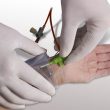Coronary angiography is essential for patients admitted with non-ST-elevation acute coronary syndrome, since it allows physicians to confirm the diagnosis, stratify the risk, and define the revascularization and antithrombotic management strategies. There is no doubt that these patients should be studied invasively, but the timing for that is still uncertain. Coronary catheterization within<a href="https://solaci.org/en/2017/10/09/early-coronary-angiography-in-high-risk-non-st-elevation-acs/" title="Read more" >...</a>
VALIDATE-SWEDEHEART: bivalirudin seems to be losing ground
Another important work that does not see the benefits of bivalirudin over heparin as monotherapy as regards both efficacy (death and MI) and safety end points (bleeding) in patients undergoing acute myocardial infarction with and without ST elevation. The study VALIDATE-SWEDEHEART, presented at ESC, simultaneously published in the New England Journal of Medicine, randomized 6000 patients<a href="https://solaci.org/en/2017/09/04/validate-swedeheart-bivalirudin-seems-to-be-losing-ground/" title="Read more" >...</a>
Transradial access shows no benefit of bivalirudin
The aim of this study was to compare bivalirudin against heparin in patients with ST elevation acute myocardial infarction undergoing transradial primary PCI. Both bivalirudin and the transradial access are strategies aimed at reducing bleeding complications in patients undergoing acute MI. However, the benefit of their combined use is not year clear. Even though<a href="https://solaci.org/en/2017/06/21/transradial-access-shows-no-benefit-of-bivalirudin/" title="Read more" >...</a>
Carotid stenting or endarterectomy? considering vascular anatomy…
Complex vascular anatomy could increase the risk of periprocedural stroke during carotid artery stenting (CAS). However, no randomize study has provided evidence showing this potential difficulty should inform the choice between carotid stenting and endarterectomy. This study included 184 patients with symptomatic lesions of the internal carotid randomized to CAS vs. endarterectomy in the context<a href="https://solaci.org/en/2017/05/28/carotid-stenting-or-endarterectomy-considering-vascular-anatomy/" title="Read more" >...</a>
Bivalirudin reduces bleeding rate in carotid stenting
Courtesy of Dr. Carlos Fava Bivalirudin has been shown to reduce bleeding in carotid stenting and maintain its efficacy. Even though carotid stenting has shown benefits, these remain unclear. With this in mind, four studies were analyzed (one randomized) including 7,784 patients undergoing carotid stenting with unfractioned heparin vs. bivalirudin. No difference was<a href="https://solaci.org/en/2017/05/08/bivalirudin-reduces-bleeding-rate-in-carotid-stenting/" title="Read more" >...</a>
Is it safe to perform percutaneous treatment in acute pulmonary thrombosis?
Courtesy of Dr. Carlos Fava Massive and submassive pulmonary embolism (PE) has traditionally been treated with anticoagulation and catheter direct thrombolysis (CDT), but the safety and efficacy of this treatment has not been yet properly assessed. The study analyzed 137 patients presenting acute PE massive or submassive. All patients received CTD associated to heparin<a href="https://solaci.org/en/2017/05/01/is-it-safe-to-perform-percutaneous-treatment-in-acute-pulmonary-thrombosis/" title="Read more" >...</a>
Catheter-directed thrombolysis for pulmonary embolism: a safe technique
Courtesy of Dr. Brian Nazareth Donato. The conventional treatment for patients with pulmonary embolism (PE) has traditionally been anticoagulation plus systemic thrombolytics, or surgical embolectomy, reserved for high risk patients. Even though it has been shown systemic thrombolytics reduce mortality in PE patients at high or intermediate risk, its use has been limited given the<a href="https://solaci.org/en/2017/04/18/catheter-directed-thrombolysis-for-pulmonary-embolism-a-safe-technique/" title="Read more" >...</a>
Patients with Plaque Erosion: Management without Stenting
This small study presented at ESC and simultaneously published in the European Heart Journal evaluated patients undergoing acute coronary syndrome caused by plaque erosion identified by optical computed tomography (OCT). The study showed it can be managed with conservative antithrombotic therapy and without stenting. Patients with plaque erosion can receive dual antiplatelet therapy, ticagrelor and aspirin<a href="https://solaci.org/en/2016/09/07/patients-with-plaque-erosion-management-without-stenting/" title="Read more" >...</a>
No Extra Benefit for Combined Use of Bivalirudin and Transradial Approach
The aim of this meta-analyzis was to study the relation between bivalirudin and access site in patients undergoing acute coronary syndrome (ACS). Both bivalirudin and the transradial access site are strategies aiming at reducing bleeding complication in patients with ACS undergoing invasive approaches. The interaction of both strategies and the potential benefits of their combined use<a href="https://solaci.org/en/2016/08/05/no-extra-benefit-for-combined-use-of-bivalirudin-and-transradial-approach/" title="Read more" >...</a>
Bivalirudin could be beneficial in peripheral PCI
Original Title: Bivalirudin Is Associated with Improved In-Hospital Outcomes Compared with Heparin in Percutaneous Vascular Intervention. Observational, Propensity –Matched Analysis From the Premier Hospital Database. Reference: Carey Kimmeslstiel, et al. Circ Cardiovasc Interv. 2016 Jan;9(1). Courtesy of Dr. Carlos Fava Lower limb vascular interventions are increasing in number and bleeding is one of its most<a href="https://solaci.org/en/2016/02/16/bivalirudin-could-be-beneficial-in-peripheral-pci/" title="Read more" >...</a>









